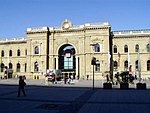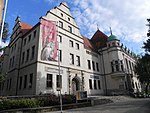Siege of Magdeburg (1806)
1806 in Germany1806 in PrussiaBattles in Saxony-AnhaltBattles of the War of the Fourth CoalitionConflicts in 1806 ... and 7 more
History of MagdeburgNovember 1806 eventsOctober 1806 eventsSieges involving FranceSieges involving PrussiaSieges of the Napoleonic WarsUse shortened footnotes from June 2021

The siege of Magdeburg (French: Siège de Magdebourg) was a siege of the city that took place from 25 October to 8 November 1806 during the war of the Fourth Coalition. A French force, initially under the command of Marshal Grand Duke of Berg Joachim Murat, then a French army Corps under the command of Marshal Michel Ney laid siege and eventually obtained the surrender of Franz Kasimir von Kleist's Prussian force that had taken refuge in Magdeburg, Prussia's second city.
Excerpt from the Wikipedia article Siege of Magdeburg (1806) (License: CC BY-SA 3.0, Authors, Images).Siege of Magdeburg (1806)
Goethestraße, Magdeburg Stadtfeld Ost
Geographical coordinates (GPS) Address Nearby Places Show on map
Geographical coordinates (GPS)
| Latitude | Longitude |
|---|---|
| N 52.1333 ° | E 11.6167 ° |
Address
Goethestraße 51
39108 Magdeburg, Stadtfeld Ost
Saxony-Anhalt, Germany
Open on Google Maps









